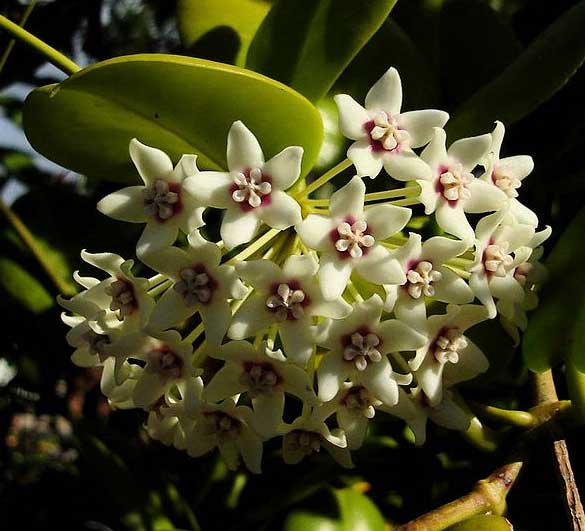
Hoya australis (*)
Classification System: APG IV
Superregnum: Eukaryota
Regnum: Plantae
Cladus: Angiosperms
Cladus: Eudicots
Cladus: Core eudicots
Cladus: Asterids
Cladus: Lamiids
Ordo: Gentianales
Familia: Apocynaceae
Subfamilia: Asclepiadoideae
Tribus: Marsdenieae
Genus: Hoya
Sectio: H. sect. Pterostelma
Species: Hoya australis
Subspecies: H. a. subsp. australis – H. a. subsp. melanesica – H. a. subsp. nathalieae – H. a. subsp. oramicola – H. a. subsp. rupicola – H. a. subsp. sana – H. a. subsp. tenuipes
Name
Hoya australis R.Br. ex J.Traill, 1830
References
Brown, R., 1830. Transactions of the Horticultural Society of London 7:28.
Links
Govaerts, R. et al. 2018. Hoya australis in World Checklist of Selected Plant Families. The Board of Trustees of the Royal Botanic Gardens, Kew. Published on the internet. Accessed: 2018 Oct. 08. Reference page.
Hassler, M. 2018. Hoya australis. World Plants: Synonymic Checklists of the Vascular Plants of the World In: Roskovh, Y., Abucay, L., Orrell, T., Nicolson, D., Bailly, N., Kirk, P., Bourgoin, T., DeWalt, R.E., Decock, W., De Wever, A., Nieukerken, E. van, Zarucchi, J. & Penev, L., eds. 2018. Species 2000 & ITIS Catalogue of Life. Published on the internet. Accessed: 2018 Oct. 08. Reference page.
International Plant Names Index. 2018. Hoya australis. Published online. Accessed: Oct. 08 2018.
The Plant List 2013. Hoya australis in The Plant List Version 1.1. Published on the internet. Accessed: 2018 Oct. 08.
Tropicos.org 2018. Hoya australis. Missouri Botanical Garden. Published on the internet. Accessed: 2018 Oct. 08.
USDA, ARS, Germplasm Resources Information Network. Hoya australis in the Germplasm Resources Information Network (GRIN), U.S. Department of Agriculture Agricultural Research Service. Accessed: 07-Oct-06.
Vernacular names
English: Wax vine
lea faka-Tonga: laumatolu
Hoya australis, commonly known as the waxvine or common waxflower, is one of the species in the genus Hoya. It is a vine found on rainforest margins and rocky areas, and occurs in eastern and northern Australia, from Western Australia,[1] through the Northern Territory and coastal Queensland from Cape York to northern New South Wales. It is a popular garden plant, noted for its fragrant flowers.
Taxonomy
The common waxflower was originally described in 1828 by the botanist Robert Brown, its specific epithet australis is Latin for "southern".[2]
Subspecies
Hoya australis australis
Hoya australis oramicola — described by botanists Paul Forster and David Liddle in 1991, it is restricted to Bathurst Island off the Northern Territory coast.
Hoya australis rupicola in the Kimberley (Western Australia) region and the Northern Territory
Hoya australis sana
Hoya australis sanae
Hoya australis tenuipes — features glossy round foliage that is thinner compared to other Hoya australis varieties. In the warmer season, it produces clusters of white flowers with red centers.[3]
Description
Hoya australis is an evergreen climbing vine which may reach 4–10 m (13–33 ft). It has simple opposite glabrous (shiny) leaves 3–6 cm long and 2–5 cm wide. They are succulent (thick and fleshy) and elliptical or ovate in shape; leaves growing in sunnier positions are a more yellowish green while those in shadier locales are dark green in colour. Flowering may occur at any time of year. The flowers appear in axillary umbellate clusters at the apex of 0.5–2.5 cm long peduncles. Each flower is 1.5–2.5 cm in diameter, with five thick, waxy, triangular petals, and white with each lobe marked red. They have a strong sweet scent and produce abundant nectar.[4]
Ecology
It serves as a food plant for the caterpillars of the Queensland butterfly the no-brand crow (Euploea alcathoe),[5] and the common Australian crow (E. core).[6] Flowers are pollinated by the southern grass-dart (Ocybadistes walkeri).[7]
Distribution and habitat
In Australia, it is found from Grafton in northern New South Wales northwards to Cape York in north Queensland. It grows on the edges of rainforest and in rocky exposed habitats.
Cultivation
It is a popular garden and houseplant in Australia, where it flowers best in a well-lit position. It is often grown in containers and trained to grow on trellises on verandahs, fences and in glasshouses. It is a butterfly-attracting plant in the garden.[6] It can be grown indoors provided it receives direct sunlight.[8]
References
Spooner, Amanda; Western Australian Herbarium (1999). "Hoya australis subsp. rupicola (K.D. Hill) P.I. Forst. & Liddle". Florabase — the Western Australian Flora. Department of Biodiversity, Conservation and Attractions.
Simpson, D.P. (1979). Cassell's Latin Dictionary (5th ed.). London: Cassell. p. 883. ISBN 0-304-52257-0.
"Overview of Hoya Australis". MicroVeggie.
Elliot, Rodger W.; Jones, David L.; Blake, Trevor (1990). Encyclopaedia of Australian Plants Suitable for Cultivation. 5, Gr–J. Port Melbourne: Lothian Press. pp. 386–7. ISBN 0-85091-285-7.
Braby, Michael F. (2005). The Complete Field Guide to Butterflies of Australia. Collingwood, Victoria: CSIRO Publishing. pp. 194. ISBN 0-643-09027-4.
Clyne, Densey (2000). Attracting Butterflies to Your Garden. Sydney: Reed New Holland. p. 50. ISBN 1-876334-56-8.
Forster, Paul I. (1992). "Pollination of Hoya australis (Asclepiadaceae) by Ocybadistes walkeri sothis (Lepidoptera: Hesperidae)". Australian Entomological Magazine. 19: 39–43. doi:10.3316/informit.109007012276201.
Ratcliffe, David; Ratcliffe, Patricia (1987). Australian Native Plants for Indoors. Crows Nest, NSW: Little Hills Press. p. 98. ISBN 0-949773-49-2.
Retrieved from "http://en.wikipedia.org/"
All text is available under the terms of the GNU Free Documentation License

